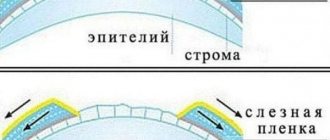The beginning of the autumn conscription into the army is literally just around the corner. As you know, before being sent to service, all young people must undergo a thorough medical examination. As sad as it may be, the health of conscripts quite often leaves much to be desired. In recent years, ophthalmological ailments have become a cause of particular concern, preventing young men from completing military service. The list of these diseases is quite wide and includes a lot of different deviations that require dynamic monitoring by a specialist and regular treatment. Therefore, young people of military age who have vision problems should have an idea of what diseases they will have to forget about doing military service.
Army and vision
It is common to believe that a young man of military age who has poor eyesight cannot enlist in the army for military service. The ability to serve, as well as its absence, is determined by the regulatory provision “Schedule of Diseases,” which provides all the necessary information regarding visual pathologies and the categories that they provide for. Articles 29-36 contain instructions on eye diseases; it is to these chapters that IHC specialists turn to determine the fitness category of a conscript.
Some pathologies make it possible to indisputably establish one or another category, while others, on the contrary, cause controversy and disagreement. The latter most often includes:
- Myopia is a pathology in which a person sees distant objects unclearly;
- Farsightedness – loss of visual acuity and the ability to see nearby objects;
- Astigmatism is a pathology of the visual organs associated with various deviations of the cornea, lens, or the shape of the eye itself; If you have this disease, a person cannot fully focus on objects located at any distance.
In addition to the above-mentioned diagnoses, an important factor is visual acuity. Impaired refraction of the eye does not in all cases correspond to deviations of this parameter, therefore each specific situation is considered by the members of the IHC on an individual basis.
Eye test at the military registration and enlistment office
Young people of military age are often interested in the exact form of a medical check to determine the correct functioning of organs and systems, including vision, in the case of a commission at the military registration and enlistment office. And this has its own peculiarities, since it is at the military registration and enlistment office that they decide whether a person will serve in the army or remain in civilian life.
To begin with, it must be said that the relevant requirements, which involve the formation of survey results of conscripts, are regulated by a special government decree dated the Fourth of July 2013. The appendix to this regulatory document contains precise data on exactly when an examination may become the basis for the impossibility of serving in the armed forces.
People who have passed the appropriate test can be divided into several categories. Group A assumes full fitness for service.
In the case of Group B, restrictions regarding service will be minimal, and the person can serve in almost any branch of the military. People classified as Group B may serve with significant restrictions.
And representatives of group G are considered temporarily unfit for service. And only those who belong to group D can completely forget about the possibility of serving in the armed forces of our country.
In addition, you can often find numerical prefixes in categories. This is an indicator according to which it is possible to determine in which troops service can take place if there is one or another restriction characteristic of groups B and C. However, in reality, these figures are rarely taken into account.
As for the examination of the state of vision, which takes place at the military registration and enlistment office, in this case there is a clear list of diseases and their stages when further service is not possible.
Any illnesses that are the result of injuries, burns of individual parts of the eyes, lacrimal ducts, and the like, should be classified as categories B to D. Complete exemption from service is possible only when anatomical deviations in the position of the eyelids, orbits, and some others are observed elements when this led to impairment of motor functions, but only in both eyes.
Problems that can lead to a lack of chances for service also apply to those diseases that include burns of the sclera, cornea, lens, and so on. But only with a pronounced progressive decrease in the quality of visual function can we say that a person is classified in group D.
If the same is observed only in one eye, or if this does not affect the quality of vision, then the conscript receives category B in the relevant documents.
If the inspection revealed retinal detachment, then this may well be the reason for a decision to assign the status of unfit for duty. But, again, this is only possible for situations where the problem affects both eyes.
Glaucoma may not be as common among young people as among older people, but sometimes there are conscripts with similar problems. They may refuse to serve if the specified visual deviation is at an advanced stage in both eyes. But a similar problem, but only in one eye, makes a person fit only in category B.
Diseases of the eye muscles, refractive error, as well as a number of other vision problems can be a real basis for denial of the right to serve. The main thing is that the relevant facts are confirmed by examination.
Naturally, many diseases cannot be the basis for a residual commission, since they can be eliminated over time. In this case, a temporary deferment from service is given, followed by a vision test within the framework of the next commission.
If it turns out that the conscript managed to improve his vision, or it was restored naturally, then the decision to assign him a health category may be revised. Complete refusal is possible only when vision problems are permanent in nature, and it is not possible to solve them either in traditional or operational ways.
A similar statement is true for those people who have pronounced problems since childhood.
If a conscript is sure that his state of health leaves much to be desired, and if he does not want to serve, then he should take with him to the medical commission all the documents that can prove he is right. As a rule, these are the results of examinations in a clinic, independent medical centers, and the like. So, storing this data is simply necessary.
Expert opinion
Davydov Dmitry Stanislavovich
Deputy Head of the Military Commissariat
As for the direct vision test, it occurs as follows. To begin with, standard monitoring of visual acuity and some other parameters is carried out.
To do this, the conscript reads the letters that are shown in the table. If the inability to see the inscriptions occurs too early, this means that further examination may be required.
This happens exclusively using hardware techniques. The eyes are instilled with special drops.
They dilate the pupils slightly and can change the state of visual function at the moment. And, given that the quality of visual conditions can even be improved for a short period of testing, it may be necessary to conduct a second examination, but with the use of other drops or without them at all, if possible.
This is important to know: Who is responsible for military registration in the organization
If some problems have been detected, but there is no confidence that the diagnostic tools will give the desired result, it may be necessary to undergo a subsequent more detailed examination in a specialized ophthalmology clinic.
The decision of the military commissariat is decisive, and only a court order can change it. This is precisely what many conscripts who are not confident in their ability to serve take advantage of. They can appeal the relevant decision, protecting their legal rights.
In any case, you need to remember that vision problems, which can become the basis for a conscript’s commission even before he completes his service, can be very serious. So, it is in the interests of the patient himself to undergo a full examination, which would give the whole picture of health as accurately as possible.
This will allow you to choose the treatment that best suits this particular case. In addition, in our country the number of people who suffer from vision problems that were previously characteristic exclusively of the older generation is constantly increasing.
And this is another reason to think about how healthy our lifestyle is, and whether we can maintain our health in the future, including the quality of the visual apparatus.
Additionally, it is necessary to mention the special status of people who have received functional eye disorders as a result of an acute illness or exacerbation of chronic problems. The same applies to injuries and surgical procedures.
Regardless of the severity, category G is considered the minimum fitness category. As you remember, it only temporarily limits the ability to perform service.
This means that there is a high probability of the decision being revised in the future. Therefore, you need to be extremely careful before going to the military commissariat for examination, since the rules for assigning categories of fitness for service have their own characteristics.
And your, even a very significant visual defect, can only become a basis for restrictions regarding military service, but not a complete refusal of this honorable duty.
With what kind of vision are they not enlisted in the army?
According to the “Schedule of Diseases,” each eye-related pathology has its own fitness category.
- If a conscript has any minor changes (for example, conjunctivitis or slightly reduced visual acuity, myopia up to 3 diopters, hyperopia up to 6 diopters and astigmatism up to 2 diopters), he is assigned category “A”, indicating that the young man is entering the service in the Armed Forces.
- Category “B” is given to those citizens who have been diagnosed with pathologies of the cornea, lens, optic nerve, retina, as well as initial degree glaucoma. All these are grounds for enrolling a conscript in special branches and branches of the military that do not require serious physical activity.
- O on a military ID means limited fitness for duty. Such conscripts are released from the army in peacetime, but in a dangerous military situation they are, as a rule, mobilized. The pathologies included in this group are the following: rupture or detachment of the inner membrane of the eye, pronounced diseases of the retina, lens, cornea, actively progressive glaucoma, as well as astigmatism, myopia and hypermetropia (4-6 diopters / 6-12 diopters / 8-12 diopters).
- Category “G” is assigned when a young man needs temporary exemption from military service. The basis for obtaining such a mark is the postoperative period, as well as various eye pathologies that are in the acute phase of development. A deferment from the army makes it possible to recover from surgery performed on the eyes, or to wait for remission of a particular disease of the visual organs.
- O in the World Bank speaks of the young man’s complete unfitness for military duty. Citizens who have severe visual problems are not conscripted into the army either in peacetime or in wartime. These are persons with severely reduced or completely absent vision, with myopia and hyperopia above 12 diopters, with astigmatism more than 6 diopters, glaucoma that is not in the initial stage of development, etc.
How to skew according to vision?
Imitating poor eyesight will not help a conscript citizen avoid military service. The only convincing argument can only be a medical report. To do this, even before receiving the summons, you need to go to the clinic to undergo an examination, which is aimed at detecting vision problems. After the results of the study are received, you need to make photocopies of the doctor’s report and laboratory or instrumental studies.
When you need to come to the military commissariat, you must definitely take with you the original documents that were issued at the clinic; photocopies can be left at home. During a medical examination at the military commissariat, all available certificates must be presented to the ophthalmologist, who, most likely, will want to verify their veracity and order a medical examination. If the results of this procedure are confirmed by the commission, then the young man will be given an exemption from military service, he will issue a military ID and will be listed in the reserves.
Can they be accepted into the Air Force with poor vision in one eye?
In accordance with the law, young people who have insufficiently good vision in one eye can be drafted into the Armed Forces, however, on the condition that the visual acuity of this eye is within the acceptable values. 0.4 or more is exactly the indicator that is considered normal for entering military service.
Young men who are missing one eyeball or one eye is sighted and the other is blind are also enlisted in the army, but under the same condition: the vision of the active eye must meet acceptable standards.
There is another situation when a young person has an eyeball, but the eye is completely blind and the visual acuity of the other is 0.4 diopters.
In all of these cases, conscripts receive category “B”, meaning enrollment in the reserves with possible mobilization in wartime. Persons who do not have one eyeball or one eye is blind, and the visual acuity of the other is 0.34 diopters or less, are completely exempt from service in the Armed Forces.
What tables are used to determine drivers' vision?
While driving, the driver receives almost all information through vision. This is why most countries pass laws that prohibit people whose visual acuity is below the declared level from obtaining a driver's license. For category “B” it is 0.6 on the best eye and 0.2 on the worst.
For other categories, restrictions are more stringent. To check the vision of drivers, they use the Sivtsev table, sometimes also the Golovin table.
Additionally, tests are carried out to calculate color blindness.
Expert opinion
Davydov Dmitry Stanislavovich
Deputy Head of the Military Commissariat
You don’t have to go to a professional doctor; print out the vision test tables in A4 and hang them on the wall in your office or bedroom. To test visual acuity, you need:
This is important to know: How many years do you have to serve in the Russian army?
- Print the required tables. If the characters are poorly printed, highlight them with ink or a black marker for contrast.
- Position the table so that the tenth line is at eye level.
- Illuminate the symbols with a lamp with a power of at least 40 W.
- Move 5 meters away, close your left eye with some kind of screen.
- Without squinting, read all visible signs.
- Repeat the procedure with the other eye.
- Based on the notes on the right side of the table, find out your visual acuity.
You can also take an online test for color blindness at home.
Try to relax during the examination. Indications may vary - it all depends on fatigue, lighting, weather and time of day. In this case, repeat the checks under different circumstances.
The slightest difference from the previous result should make you wary.
What other eye diseases prevent you from joining the army?
Those young people who have the following problems with the visual organs are exempt from military service or enlisted in the reserves:
- Pathologies of the lacrimal ducts;
- Strabismus taking into account the lack of binocular vision;
- Ulcerative blepharitis;
- Glaucoma 2, 3, 4 degrees;
- Optic nerve atrophy;
- Artifakia, aphakia;
- Retinal tear or detachment;
- Congenital deviations of the eyelids (inversions or inversions, fusion of the eyelids);
- Pronounced lagophthalmos;
- Tapetoretinal abiotrophy;
- Myopia more than 6 diopters;
- Farsightedness more than 8 diopters;
- Astigmatism more than 6 diopters.
In case of significantly reduced visual acuity, suitability categories “B” and “D” are also provided. Such situations are:
- Absence of an eyeball, taking into account the visual acuity of the other eye is 0.4 or higher;
- Visual acuity of one eye is 0.3, and the other - 0.1 (or 0.09-0.4 / 0.09-less than 0.3;
- Visual acuity of both eyes is below 0.2;
- The absence of one eye, provided the clarity of the other is within 0.3 or less.
If there are burns or injuries to the sclera, cornea, iris, vitreous or ciliary body, or retina, the likelihood of not being accepted into the army is also quite high.
OTHER VISUAL DISEASES
The Regulations on Military Medical Examination establish an exhaustive list of diseases for which people are not accepted into the army. The list of eye diseases that can be released from the army and enlisted in the reserves includes:
- various types of cattle;
- retinal detachment;
- glaucoma;
- complete blindness;
- dysfunction of the eye muscles and joint movement of the eyeballs;
- diseases, results of injuries and burns of the tear ducts, eyelids, orbits, conjunctiva;
- color vision impairment;
- congenital or acquired absence of the eyeball.
This is important to know: Which military registration and enlistment office does the street belong to?
Why is good vision important for military service?
Limitations on physical activity exist for all conscripts who have problems such as myopia, hypermetropia and astigmatism. And this is no coincidence: serious physical activity can cause the development of various complications, and the most dangerous of them is blindness.
For example, weight training increases eye pressure, which in turn leads to the development of glaucoma. It forms when fluid in the eye cannot drain naturally. During normal functioning, this is accomplished through the trabecular meshwork. However, it tends to become clogged when eye pressure increases, as a result of which the nutrition of the eye is disrupted. There is an accumulation of fluid, which puts strong pressure on the optic nerve and provokes the death of nerve endings, which ultimately becomes the main cause of vision loss.
Normal vision is of particular importance within the specifics of military service: a soldier must see well when shooting, while passing standards, while on duty, etc.
What is astigmatism?
Astigmatism is a type of refractive error of the eye, which is characterized by different refractive powers of rays along the two main meridians. The patient's vision becomes blurred as a result of curvature of the cornea, and less commonly, the lens. As a result, the image does not accurately fall on the retina and image distortion occurs.
The main reasons include:
- Eye injuries;
- Eye surgeries;
- Impaired functioning of the extraocular muscles.
Symptoms may include pain and a burning sensation in the eyes, blurriness and loss of clarity of the image, and double vision.
Do they take you into the army after vision correction?
Many young people decide to undergo corrective surgery to improve their vision. For those young men who still want to enroll in military service, this is the only saving chance. However, whether such conscripts are suitable for enlistment in the army is a rather controversial issue.
In some cases, after vision correction, young people who previously had problems with the visual organs are able to correct category “D” in their VB to “B”. In case of minor pathologies that can be successfully treated surgically, a second medical examination is assigned category “B”.
However, it is worth remembering that after corrective surgery, the eyes become extremely vulnerable, so experts strongly recommend avoiding serious physical exertion, not overstraining the visual organs, and especially not exposing them to various injuries. In this regard, you should think carefully about whether staying in the army will be justified and whether this factor will lead to the development of further negative consequences.
6-12 months after the operation, the young man must undergo re-examination in order to review the diagnosis and determine his suitability or unsuitability for military service.
be careful
Recently, operations to restore vision have been gaining immense popularity, but not everything is so smooth.
The danger is that glasses and lenses do not work on operated eyes, i.e. a person begins to see worse and worse, but cannot do anything about it.
What should people with low vision do? Indeed, in the era of computers and gadgets, it is almost impossible to have 100% vision, unless of course you are genetically gifted.
But there is a way out. The Ophthalmological Research Center of the Russian Academy of Medical Sciences managed to develop a drug that completely restores vision without surgery (myopia, farsightedness, astigmatism and cataracts).
Astigmatism and the Army 2021
In medicine, astigmatism is commonly understood as a refractive error of the eye. It is for this reason that vision begins to distort and become blurry, and focusing on objects deteriorates at different distances.
Experts distinguish several types of pathology: simple, complex or mixed. However, this is not the factor that influences a conscript’s suitability for enlistment in the Armed Forces. For representatives of the VVC, the determining factor is not the type of disease, but the degree of its severity.
And there are also three of them:
- A weak degree is characterized by a value of up to 3 diopters;
- With an average refraction difference is from 3 to 6 diopters;
- It is worth talking about a strong degree if the difference between these values is determined by 6 diopters or more.
In accordance with the “Schedule of Diseases”, and more specifically with Article 34 of this provision, with a strong degree of astigmatism, the conscript is assigned fitness category “D”. The average degree of the disease requires receiving category “B” or “B”. With a violation of up to 4 diopters, a young man may be called up for military service.
When undergoing VVC if a young man has problems with the visual organs, many factors are taken into account. And we are talking not only about the presence of pathology as such, but also about the recorded facts of seeking medical help, about the condition registered with an ophthalmologist. Serious deviations are a good reason for not accepting a conscript into the Armed Forces, but in case of mild illnesses, the issue of enrollment in the army is decided on an individual basis. Most often, such situations involve the performance of military duty with certain restrictions.
Exemption from the army based on vision
The army and vision is a fairly broad topic. There are many eye diseases, for which each of them has a separate category of suitability. What eye diseases are exempt from military service?
Myopia or myopia is a disease in the ophthalmological field when there is a violation of the curvature of the lens, in which a young person is unable to focus his gaze on objects located in the distance.
A medical examination for myopia is carried out according to Article 34 of the Schedule of Diseases. It is possible to issue a military document on vision only if myopia is more than 6 diopters.
The suitability category in this embodiment corresponds to the following indicators:
- “B” – over 6 and up to 12 diopters;
- “D” – more than 12 diopters.
Farsightedness also occurs when the lens is curvature. If at least one eye has a similar pathology, then a diagnostic conclusion is made: hypermetropia.
For the purpose of exemption from military service, the characteristic features of farsightedness must be the following:
- “B” – more than 8 and less than 12 diopters;
- “D” – over 12 diopters.
In other options, a young man is considered fit or partially fit to serve in specific troops.
Astigmatism. There are 3 forms: mixed, simple and complex. In the army, it is possible to find yourself with any of these violations, since when determining suitability, specialists look not at the type of violation, but at the stage of its formation:
- Weak – the difference in refractions in two meridians is up to 3 diopters;
- Average - the difference in refractions in two meridians is 3-6 diopters;
- Strong - the difference in refraction in two meridians is more than 6 diopters.
Whether someone with astigmatism will be hired depends on the stage of the pathology. Astigmatism of a strong stage belongs to category “D”. At the middle stage, the fitness category will be “B” or “C”. They will hire you for service with astigmatism if there is a weak stage and an average stage of up to 4 diopters.
Reviews
Dear readers, you can leave your feedback on whether people with poor eyesight are accepted into the army in the comments, your opinion will be useful to other users of the site!
Arseny
With my poor eyesight I received category “B4”. Nevertheless, I was drafted and served as a rifleman. Much also depends on the “buyer”.
Ivan
My eyesight is not very good either, -3. I recently consulted with a person who knows a lot about this matter. In general, he said that with such indicators they could well be accepted into the ground forces. Let's see how it turns out in practice. The call is coming very soon.
What should a conscript do if there are reasons not to serve due to his eyesight?
In order not to join the army because of your eyesight, you need to have this documented.
First of all, a person needs to undergo an examination (either in a clinic at his place of residence, or in any private ophthalmology clinic).
If there is a draft at this time, there is a possibility that the person will still join the army.
This is explained by the fact that even if there is an obvious presence of a disease without documentary evidence, it will not be a reason for a delay or complete restriction.
After the examination, the doctor issues a report indicating the disease and its severity.
But that’s not all: such imprisonment in itself does not constitute liberation from the army.
This is only a document on the basis of which the conscript is re-examined by a commission from the military registration and enlistment office, and if they also confirm the presence of the disease, a corresponding certificate is issued, which is the basis for restrictions.
10 charming celebrity children who look completely different today Time flies, and one day little celebrities become adults who are no longer recognizable. Pretty boys and girls turn into...
Our ancestors slept differently than we do. What are we doing wrong? It’s hard to believe, but scientists and many historians are inclined to believe that modern man sleeps completely differently than his ancient ancestors. Initially.
Why are some babies born with an "angel's kiss"? Angels, as we all know, are kind to people and their health. If your child has the so-called angel's kiss, then you are out of luck.
What kind of vision is not accepted into the army? Today there are fewer and fewer patriots in our country. Opinions about military service are constantly divided. Someone argues this way: it is the duty of every man to protect. Other citizens consider the army a relic of the past. Accordingly, conscripts are trying to find more and more reasons not to become military personnel.
There are many ways you can avoid service. But this article will talk about how to avoid the army due to your eyesight. Today this topic is very relevant, as there has been a surge in ophthalmological diseases among the country's population. Vision plays a huge role in our lives, and if it is poor from birth, then why not try to take advantage of it and avoid the hated service? So, with what kind of vision are they not accepted into the army?










